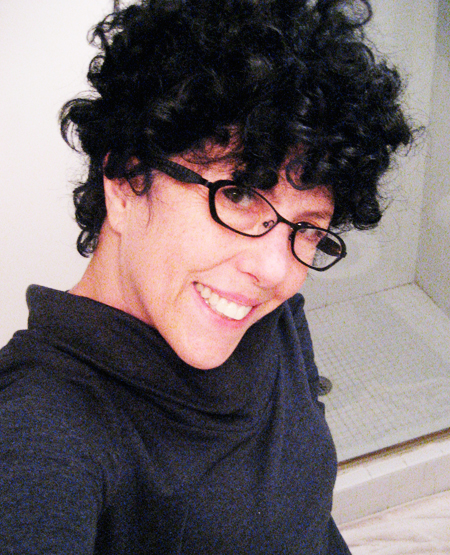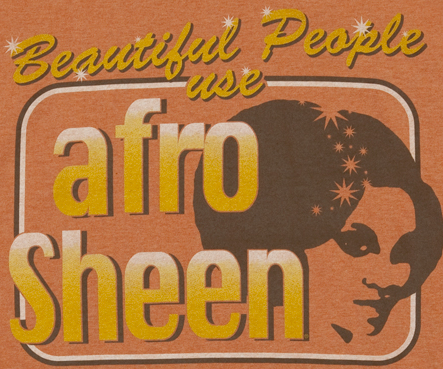The Joy, Curse, and Politics of Curly Hair (A White Girl’s Perspective)
10.20.12

Much has been discussed, filmed and written about black Women’s hair.

From fake (Photoshopped) Internet images of First Lady Michelle Obama wearing hers “natural”…

…to Chris Rock’s documentary, Good Hair, about the subject (including the vast industry surrounding the care of said locks) …

…to the recent hullaballoo about Gabby Douglas–the beautiful, talented, teenaged olympian star who should not, in my opinion, have to suffer such nonsense.
Despite certain fantasies I at times like to entertain, I am not a black woman (or a gay man, but that’s another post for another time), and it seems likely I never will be.

All of that laid out… how ’bout that photo above? Yes, I am my hair and I always have been, like it or not. It’s been my joy and power, my cursed (sometimes won, often lost) lifelong battle. From Shirley Temple in the 50’s to Dippity-Do in the 60’s, to the Afro-Sheen aisle in the 70’s. Me and my hair have been on a long and at times fitful journey together.

Curls go from super tight (sometimes referred to as kinky, but I’m never sure that’s leveraged as the compliment it should be) to looser ringlets (which sounds so darling doesn’t it?). Frizz is a whole other factor (dryness, due to over-washing and harsh treatment), as is density. Curly hair can be thin, but is most often thick if not extremely dense. Mine is pretty tight and very thick. Here’s a fun fact: my hair has to be 4x longer than straight hair to appear the same length. FOUR TIMES! I like to joke that it really doesn’t get long, it gets big.

People do compliment curly hair, but usually in weird ways such as… is your hair natural? I’m so knocked out by this question that I usually retort: Uh, do you really think I would PAY for this?? Really? I then look at them queerly b/c while they may be admiring the curls in that moment, a certain terror often appears in their eyes as they run through what it might actually be like to tangle with such hair on a daily basis. I try to hear the compliment through my long years of hair-loathing.
Oh, and hairstylists–except for the highly trained in all things curl and for you people: R.E.S.P.E.C.T!!!!–quiver in their shoes when I come through the door. Black salons and white salons are verrrry segregated, although I see that changing some. Still, white women with curls need to seek out trained stylists. Naturally curly hair MUST be cut specifically to look its best.

The joy of curly hair is very present when you are a young child. There’s a lot of ooo-ing and ahhh-ing and cheek pinching and fondling of your curls. In my case, in the 50’s, lots of Shirley Temple exclamations… Yes! Shirley Temple Jew! Charles Schulz’s character, Frieda, was an early pro-curl grrrl, but she was probably in first grade when it was still cute to have curls.

In early adolescence all of this cutesy adoration just ground to a screeching and alarming halt. Suddenly, it was incredibly uncool and unattractive to have curls. Peggy Lipton. Twiggy. The Supremes. My public schools had large Jewish and black populations and as the 60’s rolled into the 70’s there were more and more afros and jewfro’s. But weirdly, (at least in my memory) it seems it was more acceptable for boys of both persuasions. There were some black girls sporting fabulous (and huge) naturals; it seems in retrospect that they were considered radical at the very least.
And the Jewish girls? Ummm, no. Not then, and still, not too often now. Today, black women seem to be experiencing (hard won battle) more choice about hair than Jewish women, if you ask me. Most of the Jewish girls you know whose hair seems straight? Wellllll, some, but not many of us really have perfectly straight hair. It is, more likely, chemically relaxed, ironed, SERIOUSLY blow-dryed, and the latest: some Brazilian treatment that costs hundreds of dollars and lasts a few months. No thanks. And all of this because long, straight white hair is still the mark of wealth, power, success, beauty, and desirability in Western culture. It is expensive and endless work to have straight hair when you’re not born with it, and I do not believe we would bother if it didn’t matter so much.

I have tried chemical relaxers (actually “perms”), and even in the 80’s corn rows because Boy George did it and it looked so damn good on him. Ouch, the pain was intense, it lasted only a week (half of which I had a blistering headache), and Boy George was in fact prettier than me. I discovered a great love of hats, especially vintage hats for those bad hair days, which were 9 out of 10. Young white women didn’t wear pink and blue wigs back then and have only recently have been getting weaves (excuse me, I mean, extensions) and those cost the big bucks. I never went in for rasta-twists, but thought about it many times and I think it can look cool on women of all shades. My mother would have plotzed.
Recently Molly and I have been talking about self-esteem and we agree that most people either have none, or maybe have some, but the people who appear to have tons are probably faking, covering up, at least most of the time. This doesn’t comfort us… we of wild hair, or Asian eyes, or short stature, or of mixed-race families. We dream of a day when these qualities ALL will be truly celebrated, or maybe even not matter, but we feel pretty sure that although the world is greatly changing, for us, these things will likely continue to matter, and sometimes a lot. We do feel mighty lucky to live and work and attend school in a community where things are generally far better regarding diversity than many/most places across this great land of freedom. Hooray for Takoma Park!
Recently I am happy to share that things for me and my hair have turned around again. It might be a middle-age acceptance thing, and I am seeing more freaky curl flags flying in fashion and other media. As more and more sisters of all colors embrace their fabulous hair texture, I find myself standing strong in a place of defiant adoration of my own crazy curls. Most days. Oh, and btw, I’ve got NO (absolutely NO) problem with anyone straightening their hair. For me, it’s about choice. Having one and exercising it. Not feeling like you have to straighten for acceptance or to get somewhere, or to succeed. Curly sisters, let’s be tolerant of everyone’s journey.

What’s really interesting is that hair products are following along with this growing desire amongst us to free our curls, and to have them appear healthy and sexy. Black hair, Latino hair, Jewish hair… so many textures, and each deserves its own specific product line for optimal care (not race-based, texture-based). My favorite, hands-down, is DevaCurl, pictured above. It’s a system of products and treatments (and training for stylists who cut curls) that has been life-altering. DevaCurl claims to work on ALL curl, from highly textured to less so. It’s available a little cheaper at Ulta than your salon. My bio-sister — beautifully curly-topped — is a Ouidad devotee, and her hair always looks gorgeous. Of course our purses are gouged for these products… We are not talking Suave here, curlygrrrls. For now, it’s worth it. And here’s my final tip: STOP washing your hair every day. Dampen and condition, but wash it much less. Your hair will be healthier, not dirtier (yeah, another judgement!).
As Sistah Ru Paul always says: If you can’t love yourself, how the HELL you gonna love somebody else?
Do you have a curly hair story to tell? Please share!





454 Responses to The Joy, Curse, and Politics of Curly Hair (A White Girl’s Perspective)